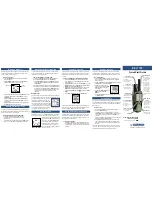
COE Communications Engineering Document
Author:
Keith Gilbertson
Rev:
A
Date:
3/08/02
Pag
e:
25
of
33
GE
TRANSPORTATION
SYSTEMS
GLOBAL SIGNALING DIVISION
Title:
12RII FCC TECHNICAL MANUAL
The MX829 device provides audio processing and filtering, for transmit audio signals. It also contains a precise limiting
circuit for maximum transmit deviation control. Digital Attenuators provide for electronic adjustment of the transmit signals.
The device contains a normal 300 Hz High Pass filter and 3000 Hz. Low pass filter for normal radio band pass audio
requirements. A 2500 Hz. low pass filter may also be selected for radio narrow band operation.
The MX829 also contains an MSK data radio modem capable of 1200 or 2400 Hz modulation and a DTMF tone generator.
The MX828 device contains circuitry for sub-audible tone encoding and decoding as well as select call tone encoding and
decoding. This device is used as the primary receive audio path and contains a digital band pass filter. The High Pass filter
contained in the MX828 has sharper roll off to eliminate and sub-audible signals from being passed on the the receive audio
devices.
The MX839 contains two digital gain amplifiers, four A/D, and three D/A circuits. Two of these digital amplifiers (U3) are
used to adjust split the main transmit modulation signal and level adjustment for the dual port modulation scheme. The
amplifiers of the second device (U6) are used to select the appropriate receive audio signal as well as provide a fine resolution
gain setting. The A/D and D/A circuits are used for various input and output functions.
10.2.7. Dispatch Call Tone Generation
The tone modes used for dispatch call functions are the select call tones generated in the MX828 or the DTMF tones generated
in the MX829. The programming in the RCF determines which tone method is used. The appropriate tone output is enabled
and routed to the TXRX modulation inputs.
10.2.8. Sub-Audible Encode/Decode
The MX828 device provides the necessary sub-audible tone encoding and decoding. The channel attribute parameters in the
RCF determine if the selected radio channel is to have sub-audible squelch tones applied. They can be independent for transmit
and receive functions. Both traditional analog CTCSS and digital DCS code formats are available.
10.2.9. Digital Tuning
In addition to the digital gain control provided for in the audio processing the RCB also provides for digital tuning voltages.
The parameters below are under software “digital” tuning control. The data for these controls is stored in the onboard
EEPROM. All of the digital tuning settings are adjusted for each radio.
Radio Frequency Adjustment
Radio frequency adjustment is accomplished with the DAC output 1 of U3. This output is dc coupled on the MB modulation
input that is connected to the TCXO in the TXRX module.
RF Power Control
RF Power Control is handled by U3 DAC output 2. This output is set to the value stored in EEPROM when ever the radio is
put in transmit mode. Two power levels are available (High and Low), selectable on a per channel basis. These levels are
assigned in the RCF channel attribute data.
Front End Tuning Voltage
Front end selector tuning is accomplished with U3 DAC output 3. This level is set to a fixed level at the specified tuning
frequency. A firmware table adjusts this voltage to allow the front end filter to track the selected receive frequency.
10.2.10. Radio Squelch Operation
The TXRX module provides a filtered noise signal “SQL”. This signal is processed by an A/D 1 input of U3. Software
processes the noise level and compares the sampled input against preset levels for Squelch Open and Squelch Close thresholds.









































